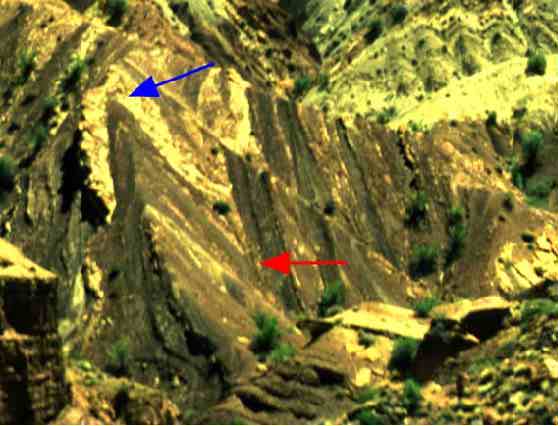
More Rule of Vs

At the red arrow, where the dipping beds meet a gully, note that the beds "V" in the direction of dip. But look at the blue arrow--there, the beds "V" in the direction opposite dip. Why?
--the "V" points in the direction of dip where the bed is incised. The blue arrow doesn't point to a gully, it points to a ridge.
The map below shows east-dipping Paleozoic rocks unconformably overlying Precambrian basement, near Loveland, Colorado.
 The Pennsylvanian-Permian
Fountain Fm. (PPf--pink) dips gently east-northeast at A, as is shown by
its prominent V. The overlying rocks also display prominent Vs. Note that
at B, however, the Permian Lyons (Ply--light gray) hardly shows a V at
all--that's because its contact with the alluvium (yellow) lies on the
valley floor, beyond the reach of the valley. Also notice the "Vs"
that point in the opposite direction where the contacts go over ridges.
The Pennsylvanian-Permian
Fountain Fm. (PPf--pink) dips gently east-northeast at A, as is shown by
its prominent V. The overlying rocks also display prominent Vs. Note that
at B, however, the Permian Lyons (Ply--light gray) hardly shows a V at
all--that's because its contact with the alluvium (yellow) lies on the
valley floor, beyond the reach of the valley. Also notice the "Vs"
that point in the opposite direction where the contacts go over ridges.
At point C, notice that the Precambrian rocks (red and brown) dip vertically--we can see that because the contacts do not conform to the topography. Notice also that those contacts are truncated by the Fountain Fm. which unconformably overlies the basement. Like the contacts to the east, the unconformity dips east-northeastward.
Back to Structure Syllabus
Back to Outcrop Patterns